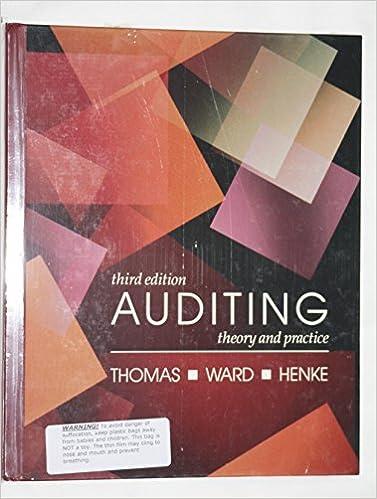Question
3. A financial audit is related to which economic factor of production? a. Allocation of financial capital b. Labor c. Land d. Manufacturing 4. Which
3. A financial audit is related to which economic factor of production?
a. Allocation of financial capital b. Labor c. Land d. Manufacturing
4. Which of the following terms is associated with the auditing standard stating: In rare circumstances, the auditor may judge it necessary to depart fron a relevant presumptively mandatory requirement. In such circumstances, the auditor should perform alternative procedures to achieve the intent of the requirement. AU-C200.26
a. Can b. May d. Should c. Must
5. Professional skepticism is best described as:
a. an intent to deceive.
b. a trustful manner.
c. a questioning mind.
d. the ability to follow professional standards.
6. Consider the following statements:
I. Conceptually, to INCREASE the level of DETECTION RISK, the
auditor would do MORE substantive testing (i.e. more
detail testing and/or analytical procedures).
II. Conceptually, as the assessed level of Inherent Risk
DECREASES, there is MORE of a need to lower detection risk
to maintain the same overall level of acceptable audit risk.
a. I is true; II is true.
b. I is true; II is false.
c. I is false; II is true.
d. I is false; II is false.
8. The risk that the procedures performed by the auditor to
reduce audit risk to an acceptable low level will not detect
a misstatement that exists and could be material, either
individually or when aggregated with other misstatements
9. Consider the following statements:
I. Materiality has both quantitative and numerical
considerations.
II. The fraud triangle involves incentive, opportunity
and rationalization.
a. I is true; II is true.
b. I is true; II is false.
c. I is false; II is true.
d. I is false; II is false.
10. Consider the following statements:
I. Conceptually, the auditor will do enough audit work in an
account to discover misstatements which individually, or
in total exceed the amount of tolerable misstatement
involving the account.
II. Tolerable Misstatement is the amount of planning
materiality that is allocated to an account or class of
transactions.
a. I is true; II is true.
b. I is true; II is false.
c. I is false; II is true.
d. I is false; II is false.
12. Consider the following statements:
I. Analytical procedures can be used in the preliminary
phase of an audit to suggest areas, or accounts which
should receive more attention during the audit.
II. If one is looking for unusual fluctuations to
investigate further, then one would tend to believe that
the current years results are expected to look similar
to the past years results.
a. I is true; II is true.
b. I is true; II is false.
c. I is false; II is true.
d. I is false; II is false.
14. A difference between error and fraud is:
a. Interest.
b. Intent.
c. Misperception.
11. Which of the following accounts would be part of the
Revenue Process [revenue cycle]?
a. Inventory.
b. Accounts payable.
c. Bad Debts expense.
d. Interest expense to finance inventory purchases.
e. None of the above. None are part of the
revenue process [revenue cycle].
refers to:
a. Audit Risk.
b. Control Risk.
c. Detection Risk.
d. Inherent Risk.
Step by Step Solution
There are 3 Steps involved in it
Step: 1

Get Instant Access to Expert-Tailored Solutions
See step-by-step solutions with expert insights and AI powered tools for academic success
Step: 2

Step: 3

Ace Your Homework with AI
Get the answers you need in no time with our AI-driven, step-by-step assistance
Get Started


